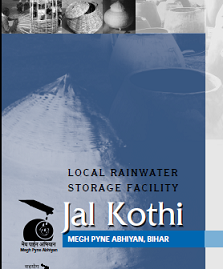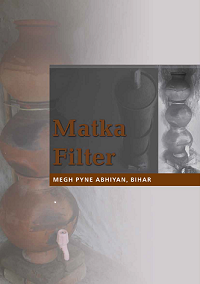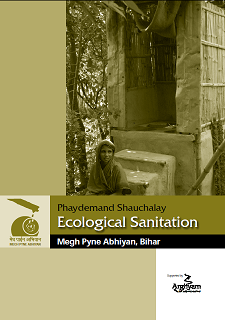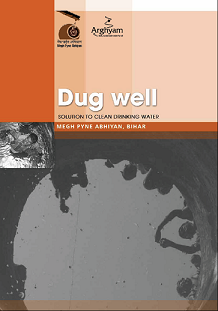The briefing papers include the following:
- Jal Kothis: A locally innovative rainwater storage structure in flood affected areas
- Matka Filter: An indigenous solution to iron contaminated water in Bihar
- Phayedemand Shauchalaya: Design and technical details of a beneficial toilet
- Dug wells: A potential safe source of drinking water for arsenic and iron contaminated region
Jal Kothis: A locally innovative rainwater storage structure in flood affected areas
 For people of Bihar, floods are a recurrent problem affecting their crops, livestock and living conditions. Most water sources including the wells and ponds become flooded or water logged during monsoons. Surrounded by dirty , polluted water during the floods, people are nevertheless forced to use the same for drinking and cooking food. This is a major problem for flood affected areas where clean drinking water is unavailable, affecting the health of the concerned communities.
For people of Bihar, floods are a recurrent problem affecting their crops, livestock and living conditions. Most water sources including the wells and ponds become flooded or water logged during monsoons. Surrounded by dirty , polluted water during the floods, people are nevertheless forced to use the same for drinking and cooking food. This is a major problem for flood affected areas where clean drinking water is unavailable, affecting the health of the concerned communities.
To overcome this, Megh Pyne Abhiyan, a campaign and functional network, began work on a project to provide clean drinking water during floods in a few districts of Bihar. In collaboration with Savera and Water Action groups, the idea was to collect rainwater and use it for drinking and cooking. Initial trials included plastic and mud containers, but were discontinued due to problems of odour, pollution and easy breakage.
The long term solution was to create a water container that would store water for a greater period of time. Experiments were carried out and the existing age old grain storage structure was innovated and modified into a rainwater storage facility now known as ‘Jal Kothi’.
Various designs with varying storage capacity and raw materials have been developed locally with the help of skilled craft persons and masons. The construction procedure and materials required are detailed in this paper.
These locally innovative ‘Jal Kothis’ not only allow flood affected people to store clean water in sufficient amount but also provides employment opportunities to local craftsmen.
Click here to read the full briefing paper
Matka Filter: An indigenous solution to iron contaminated water in Bihar
 Northern Bihar is a flood prone area where drinking water has a high iron content. Survey carried out in this area brought out the issue of high iron content in groundwater in the area. Though government had initiated ‘ Kosi Amrit Drinking Water Scheme’ in some districts which included iron removal units, it was unable to reach all concerned people.
Northern Bihar is a flood prone area where drinking water has a high iron content. Survey carried out in this area brought out the issue of high iron content in groundwater in the area. Though government had initiated ‘ Kosi Amrit Drinking Water Scheme’ in some districts which included iron removal units, it was unable to reach all concerned people.
A local technique to gauge presence of iron in water was known, but the actual contamination level could not be ascertained. A survey with the help of ‘ Development Alternatives’ was carried out to measure this . Based on the findings the necessity of iron free water was felt.
A modified ‘Matka’ filter was the outcome of this study which had the advantage of following a local technique along with providing iron free water. This specially designed mud water filter is made out of locally available clay, sand, charcoal and brick .The demand for matka filters has provided the local potters with an opportunity to strengthen their traditional livelihood practice .
The materials required, construction techniques and expenses involved are all described in the paper. The advantages and precautions to be taken have also been detailed.
Click here to read complete briefing paper
Phayedemand Shauchalaya: Design and technical details of a beneficial toilet
 Four months of floods in north Bihar plays havoc with the sanitation conditions of the people living in these areas. More affected are women, children, the old and the infirm when the existing toilets are submerged in the flood waters. Even when the floods recede, defecation is usually carried out in the open, close to the living areas. This faecal matter pollutes the water, increasing the risk of water borne diseases like typhoid, cholera etc.
Four months of floods in north Bihar plays havoc with the sanitation conditions of the people living in these areas. More affected are women, children, the old and the infirm when the existing toilets are submerged in the flood waters. Even when the floods recede, defecation is usually carried out in the open, close to the living areas. This faecal matter pollutes the water, increasing the risk of water borne diseases like typhoid, cholera etc.
The’ Phayedemand Shauchalaya’ aka beneficial toilet is different from the usual one, protecting and conserving water. It has separate collection tanks for urine and faecal matter, which are built above the ground.It is not only cheap and long lasting, but also prevents water wastage. It can be used both during and after the floods conveniently.
Megh Pyne Abhiyan (MPA) collaborated with Biome, local agencies and village panchayats to bring this concept to 5 flood affected districts in Bihar. Design details, material required and construction procedure are all explained in this paper.
Click here to read the full briefing paper
Dug wells- A potential safe source of drinking water for arsenic and iron contaminated region in north Bihar
With the invention and large scale marketing of hand pumps, dug wells slowly started losing its significance. This had led to the transformation of the wells into dumping yards of garbage and also a place, above which houses are getting constructed. However, Megh Pyne Abhiyan, a campaign and functional network started a dug well project in rural Bihar. Though initially a lot of resistance came from people against this endeavour of MPA, later on the campaign managed to bring people together to solve the drinking water problem.
wells into dumping yards of garbage and also a place, above which houses are getting constructed. However, Megh Pyne Abhiyan, a campaign and functional network started a dug well project in rural Bihar. Though initially a lot of resistance came from people against this endeavour of MPA, later on the campaign managed to bring people together to solve the drinking water problem.
Arsenic contamination of groundwater has been recognised by Megh Pyne Abhiyan (MPA) in 15 districts of north Bihar. The contamination has profound impact on human health that hampers people’s productivity and thereby affecting their livelihood. MPA has collaborated with Advanced Centre for Groundwater Development and Management (ACWADAM), Biome Solutions, Development Alternatives (DA) to understand the groundwater dynamics of the region that includes issues of water quality and its linkages to drinking water and sanitation. The details of this project is elaborated in the paper.
Click here to read the full briefing paper.
/articles/briefing-papers-jal-kothis-matka-filter-dug-wells-and-phayedemand-shauchalaya-local-0